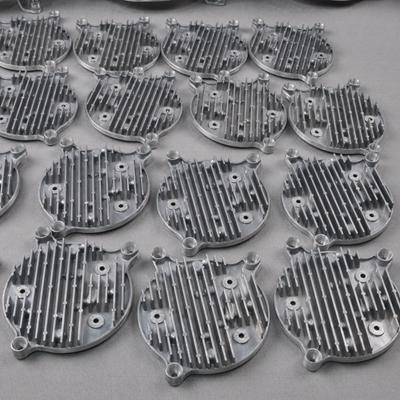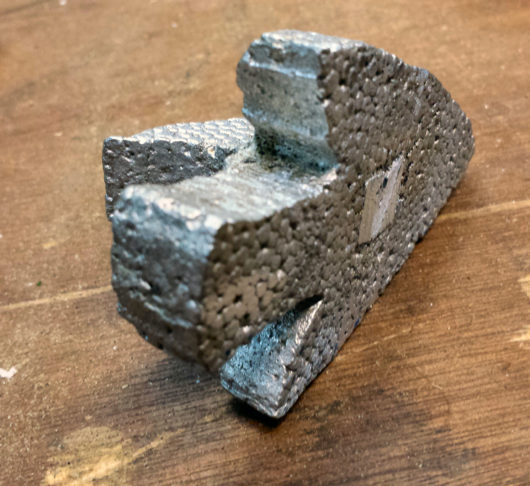Why the electronics industry depends on Precision aluminum casting
Everything About Aluminum Casting: Discovering Its Advantages and Applications in Modern Production
aluminum casting plays an important duty in contemporary production. It supplies a variety of advantages, such as light-weight buildings and exceptional deterioration resistance. Industries from aerospace to customer electronic devices count on aluminum casting for its versatility. As automation and sustainability gain grip, the procedure is evolving. Comprehending the intricacies of aluminum casting exposes its importance and capacity. What fads and advancements are shaping its future?
The Aluminum Casting Process: A Review
The aluminum casting procedure changes raw aluminum right into precise elements via a series of systematic actions. aluminum is melted in a heating system, reaching temperatures in between 660 ° C and 750 ° C. As soon as molten, the liquid aluminum is put into mold and mildews made to form the end product. 3 common casting methods are sand casting, die casting, and financial investment casting, each offering distinct advantages tailored to details applications.
After the aluminum cools and strengthens, the molds are gotten rid of, exposing the cast element. Ultimately, any excess material, referred to as flash, is cut away. Second procedures, such as machining or surface finishing, might be performed to achieve desired dimensions and surface area high quality - Precision aluminum casting. Quality control evaluations verify that the elements satisfy precise specifications. This intricate process permits makers to produce lightweight, complex shapes that offer diverse industries, from auto to aerospace
Benefits of Aluminum Casting
While numerous steel casting processes exist, aluminum casting sticks out because of its many advantages. One significant advantage is its light-weight nature, which adds to lowered power consumption in transportation and production. In addition, aluminum shows outstanding corrosion resistance, making certain long life and longevity in different environments. The electrical and thermal conductivity of aluminum also makes it a perfect selection for applications requiring reliable heat dissipation and electrical conductivity.
On top of that, aluminum casting permits intricate geometries and complex layouts, allowing makers to produce comprehensive components with accuracy. The process typically leads to a smooth surface area finish, reducing the demand for substantial post-processing. In addition, aluminum is extremely recyclable, advertising sustainability in producing practices. Its capacity to be cast in different kinds, such as sand, die, or financial investment casting, offers adaptability in manufacturing methods. Generally, these benefits make aluminum casting a preferred option in contemporary manufacturing throughout multiple industries.
Applications of Aluminum Casting in Numerous Industries
aluminum casting plays an important role in a number of crucial sectors, consisting of aerospace, auto, and consumer electronics. Its lightweight and long lasting residential properties make it an excellent selection for manufacturing components such as airplane parts, auto real estates, and electronic rooms. As sectors proceed to focus on performance and efficiency, the applications of aluminum casting are most likely to broaden additionally.
Aerospace Part Production
As the aerospace market progressively demands lightweight yet resilient materials, aluminum casting has emerged as a critical solution for manufacturing critical elements. The procedure permits the development of complicated geometries that are vital in aircraft design, such as engine mounts, architectural structures, and various installations. aluminum's superb strength-to-weight proportion adds to fuel efficiency and overall performance, making it a recommended option for aerospace applications. Additionally, aluminum spreadings provide impressive corrosion resistance, a vital consider the harsh settings experienced throughout trip. The precision of aluminum casting strategies allows producers to generate parts that meet stringent aerospace standards, making sure dependability and safety. This adaptability and efficiency make aluminum casting a very useful property in the advancing landscape of aerospace part manufacturing.
Automotive Parts Production
Transforming the auto market, aluminum casting plays an important role in the production of lightweight yet durable parts. This process allows makers to create elaborate layouts and shapes that boost vehicle efficiency and efficiency - Precision aluminum casting. Trick automobile components generated through aluminum casting consist of engine blocks, transmission housings, and suspension elements. The light-weight nature of aluminum contributes to enhanced gas efficiency and lowered exhausts, lining up with contemporary ecological requirements. Furthermore, aluminum's excellent rust resistance expands the life-span of automotive parts, better enhancing dependability. The convenience of aluminum casting enables automotive designers to innovate, integrating sophisticated modern technologies and optimizing layouts. As electrical vehicles gain traction, the demand for aluminum components is expected to rise, solidifying its significance in future vehicle production
Customer Electronic Devices Real Estate

Contrast With Other Casting Materials
When reviewing casting materials, aluminum attracts attention because of its one-of-a-kind mix of homes that typically go beyond those of choices like plastic, iron, and steel. Its lightweight nature is a significant advantage, making it suitable for applications where minimized weight is crucial, such as in automobile and aerospace sectors. In comparison, iron and steel, while supplying superior toughness, are considerably heavier, which can impede effectiveness and boost fuel consumption.

Developments in Aluminum Casting Modern Technology
As improvements in innovation remain to improve making procedures, developments in aluminum casting are arising to improve sustainability, effectiveness, and precision. One noteworthy growth is the adoption of sophisticated simulation software, which permits suppliers to anticipate casting end results and optimize layouts before production begins. This lowers product waste and assurances better elements.
Furthermore, the implementation of automated systems in the casting process has actually considerably improved manufacturing rate and consistency. Robot arms and automated pouring systems reduce human error and improve safety and security in the workplace.
3D printing technology is additionally making waves in aluminum casting by enabling the fast prototyping of mold and mildews, enabling for even more detailed styles and faster turnaround times.
Additionally, the expedition of environmentally friendly alloys and reusing strategies contributes to decreasing the ecological influence of aluminum casting operations. Collectively, these technologies are strengthening aluminum casting's duty in modern manufacturing.
Future Fads in Aluminum Casting
The future of aluminum casting is significantly formed by advanced automation technologies that improve production performance and precision. In addition, sustainable production methods are acquiring grip, as markets look for to lessen their ecological effect while keeping quality. These fads indicate a change in the direction of even more ingenious and liable strategies in the aluminum casting market.
Advanced Automation Technologies
Although the aluminum casting sector has actually long relied upon conventional methods, advanced automation technologies are positioned to change manufacturing procedures. Robotics and expert system are significantly being integrated into click for more info casting procedures, improving accuracy and performance. Automated systems streamline product handling, mold and mildew preparation, and high quality inspection, minimizing human mistake and cycle times. In addition, anticipating upkeep powered by IoT technology enables makers to expect equipment failings, minimizing downtime. These technologies additionally promote real-time data evaluation, enabling for prompt modifications to optimize manufacturing. As industries require higher-quality items at faster rates, the fostering of sophisticated automation technologies in aluminum casting is anticipated to grow, driving competitiveness and technology in the industry. This fad notes a significant change in the direction of smarter, extra reliable production practices.
Sustainable Production Practices
Advanced automation technologies not only boost efficiency yet likewise lead the way for lasting production methods in the aluminum casting industry. These technologies assist in the decrease of waste and power consumption by enhancing processes and decreasing problems. Closed-loop recycling systems have actually arised, making it possible for manufacturers to reuse scrap aluminum, thus reducing the need for virgin materials and reducing carbon footprints. In addition, developments in additive manufacturing permit more specific designs, reducing excess material use. Moreover, the assimilation of eco-friendly energy sources in manufacturing centers sustains environmentally friendly procedures. As sector requirements progress, business adopting sustainable techniques not only boost their environmental influence yet additionally acquire an one-upmanship in the market, aligning with customer demands for greener items.
Frequently Asked Concerns
Just How Is Aluminum Casting Eco-friendly Contrasted to Various Other Procedures?
aluminum casting is eco-friendly because of its recyclability, reduced power consumption, and decreased exhausts compared to various other procedures. It decreases waste and uses recycled products, adding to a lasting manufacturing approach while preserving natural deposits.
What Security Safety Measures Are Necessary During Aluminum Casting?

Can Aluminum Casting Be Recycled After Use?
Yes, aluminum casting can be recycled after use. The reusing procedure involves melting down the aluminum and eliminating impurities, permitting it to be repurposed for new castings, making it an eco-friendly option in production.
Exactly How Does Aluminum Casting Effect Production Prices?
aluminum casting can substantially influence production expenses by reducing material waste and simplifying manufacturing processes. Its light-weight nature also lowers transportation expenses, ultimately enhancing price efficiency in numerous sectors reliant on long lasting, top notch elements.
What Kinds of Finishes Are Readily Available for Aluminum Cast Products?
aluminum cast items can be ended up making use of various strategies, including anodizing, powder painting, coating, and sprucing up. Each surface improves look, deterioration resistance, and toughness, permitting personalization to fulfill particular visual and practical demands.
The aluminum casting process changes raw aluminum into precise components with a series of methodical actions. While different steel casting procedures exist, aluminum casting stands out due to its various benefits. While the automotive sector benefits substantially from aluminum casting, consumer electronics additionally utilize this manufacturing procedure for housing parts. Advanced automation modern technologies not just boost efficiency but likewise pave the means for lasting manufacturing practices in the aluminum casting sector. aluminum have a peek at this site casting can substantially impact manufacturing expenses by decreasing product waste and improving manufacturing procedures.